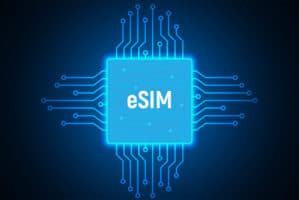The Benefits of eSIM for IoT
By Thierry Uguen
August 16, 2023

While traditional SIM cards remain critical to consumer mobile devices and IoT applications, the market continues evolving. The embedded SIM (eSIM), which is more suitable for IoT deployments, may ultimately replace the removable SIM. No matter when the switch between SIM and eSIM will occur, examining some benefits of eSIM for IoT is helpful.
The two primary characteristics of eSIM are:

Physical SIM cards are small plastic pieces of hardware inserted manually in mobile phones. They store authentication data for mobile operators, which makes connectivity possible.
Eventually, this technology evolved to support other applications like IoT. The traditional SIM is easy to access and pairs well with consumer applications and some IoT use cases. Still, it has drawbacks.
The plastic SIM has evolved into a soldered component model called the machine identification module (MIM). MIM offers a reliable solution that’s compatible with industrial deployment conditions. The eSIM component supports usage in harsh environments, including:
It can be mounted like any other component on surface mount technology (SMT) manufacturing lines. It limits manual handling and associated risks.
eSIM components are offered in various form factors with different levels of miniaturization. Examples include:

A key difference between eSIMs and physical SIMs is that physical SIMs are not secure or resilient. They present major challenges for larger-scale IoT device deployments. Their easy access makes it easy for anyone to tamper with or steal them. Security for SIMs is more involved and time-consuming for IoT managers.
On the other hand, eSIM technology is secure and robust. It can withstand vibration and damage from moisture and dust and isn’t easy to remove from a device.
A fundamental evolution offered with eSIM is the ability to control SIM remotely. It is possible to load subscriptions remotely inside the eSIM. In addition, it is possible to change and adapt subscriptions throughout the device’s lifetime.
Sending field technicians to remote facilities to install or change plastic SIM cards costs time and money. eSIM technology enables remote SIM provisioning when soldered to a device’s printed circuit board (PCB).
This flexibility is driving significant savings and increases connectivity reliability. You can eventually change it when a problem occurs with a connectivity solution provider.
This remote provisioning capability enhances flexibility over the device’s lifetime. It permits changing connectivity service providers during the device’s operational phase.

Beyond smartphones, eSIM technology can support various IoT deployments, including:
Indeed, any industry that requires reliable connectivity to function will benefit from eSIM solutions.
For example, the smart metering industry requires high flexibility while limiting the number of SKUs. eSIM helps digitize the SIM supply and simplify supply and manufacturing logistics. The automotive sector and connected cars use soldered eSIMs because they are tamper-proof and resistant to harsh environmental conditions. eSIMs also empower IoT telematics, which enables enterprises to monitor and manage fleets from one pane of glass.
Smart farming applications utilize eSIMs to monitor the health of their crops and livestock. In industrial settings, it can help monitor equipment for routine maintenance.
eSIM solutions can also support remote security cameras. These smart surveillance devices require high uplink throughput and resilient connectivity, making eSIM an optimal choice.

NExTPlus is our eSIM and multi-IMSI connectivity solution that future-proofs your IoT deployment. It leverages eSIM technology to send optimized Telit Cinterion SIM profiles to connected devices out of physical reach. We offer NExTPlus with a stand-alone eSIM or embedded in Telit Cinterion cellular modems, reducing cellular connectivity complexity.
In addition, we offer a connectivity activation service to simplify and optimize connectivity subscription provisioning and MNO selection.
Our connectivity management platform addresses small and large industrial deployment challenges. You can manage your entire deployment — down to the SIM — from one user-friendly dashboard.
With our eSIM solution, we can make your IoT journey seamless, from the factory to the last day of device operation.
Speak with our IoT connectivity experts to request an IoT connectivity starter kit.